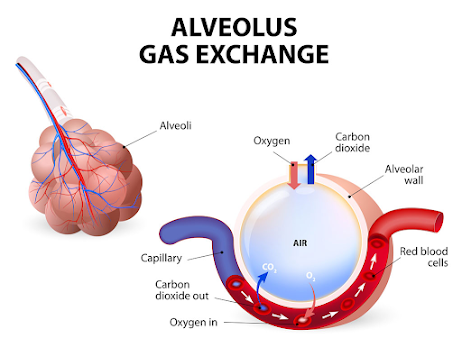Gas exchange
----------------Gas Exchange---------------
definition......................................................................................................................
TYPES OF GAS EXCHANGE GAS...................................................................................
EXTERNAL
>> it takes place in the lungs between the alveoli and
blood
>> it takes place according to the partial pressure difference of oxygen and carbon dioxide - it is passive transport
>> thanks to the single-layer squamous epithelium that covers the alveoli, diffusion (passive transport) is very easy
Carbon dioxide is transported from BLOOD TO ALVEOLI
Oxygen is transported from ALVEOLI TO BLOOD
INTERNAL
• occurs in the tissues between cells and blood
• occurs according to the difference in partial pressures of oxygen and carbon dioxide - it is passive transport
Oxygen is transported from BLOOD TO CELLS
Carbon dioxide is transported from CELLS TO BLOOD
TRANSPORT OF OXYGEN.........................................................................................
The transport of respiratory gases in the body takes place with the participation of erythrocytes and blood plasma. The erythrocytes contain the HEMOGLOBIN protein whose main function is oxygen transport.
Oxygen which is not bound to hemoglobin dissolves in plasma.
OTHER HEMOGLOBIN COMPOUNDS...................................................................
OXYhemoglobin - hemoglobin + oxygen
CARBOXYhemoglobin -> hemoglobin + carbon monoxide (II). It has 250/300 times greater affinity for hemoglobin than oxygen. By connecting it to hemoglobin, it leads to hypoxia in the body. Therefore, carbon monoxide poisoning can be fatal for humans.
CARBAMINOhemoglobin - hemoglobin + carbon dioxide
CARBON DIOXIDE TRANSPORT....................................................................................
The diffusion direction of carbon dioxide is opposite to that of oxygen.
Carbon dioxide in the blood can be transported in a form:
-> physically dissolved in plasma and in combination with plasma proteins - 10%
-> related to hemoglobin - 20%
-> HCO3- bicarbonate ions - 70%



Very interesting post!!!
ReplyDeletethank you <3
Delete